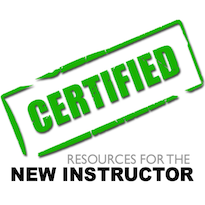Note: We get so many requests from new instructors for help in teaching their first class, so I am sharing this excellent article from a few years ago. It’s the first of a 3-part series; you can find parts 1 and 2 in the links at the end of the article.
You cue the music to begin teaching your first indoor cycling class and realize there is so much information to cover within the first few minutes of class. Will you remember it all? Will you explain everything correctly? Will someone remove the butterflies from your stomach? Welcome to part 1 and the first three tips to master your class intro.
The class introduction can be a nerve-racking experience. It first requires infiltrating a cacophony of chatter and a half dozen in-depth conversations. Once you get everyone’s attention (well, almost everyone), you risk sounding like a cattle auctioneer as you try to relay a seemingly endless stream of information.
A word of advice: Do not get down on yourself. You are going to mess up your intro more times than you can imagine, but with practice and repetition, you will establish your own style and sequence.
TIP #1: Get Their Attention and Set the Stage
As I mentioned above, it can be intimidating to take control of the class when everyone appears preoccupied with conversations and tasks that do not involve you. Nonetheless, it is time to grab the reins. My first words are designed to announce my presence and interject humor to ease the awkwardness.
Welcome, everyone! It is time to get this installation of pain and suffering underway. How is everyone tonight (this morning, etc.)? [Pause as if waiting for a reply]. Excellent. I can see we have our game faces on and we are ready to go.
Then I deal with the chatty Cathys (sorry, Cathy):
I also hear some chatter, which I am happy about. There is no reason we shouldn’t get to know each other. Let’s wrap up those conversations in the next 2 minutes so we can focus and minimize distraction.
TIP #2: Give Them Something to Do
We have a lot of information to divulge and we do not want people waiting aimlessly while we do it. Give them a starting point and something to do:
Let’s continue warming up. Make sure you have noticeable resistance on the bike—enough to emulate an easy road and alert your legs and lungs that our ride has begun.
If your bikes have computers (heart rate, power, cadence), simply encourage riders to use them and become aware of the numbers. I would avoid any discussion about zones and ranges at this point. You can give them more details later. Here is an example using the Schwinn A.C. with MPower console:
I want to encourage you to use the computers on your bikes, even if you just observe them from time to time. Simply push the center bottom button on the console. It has a picture of a lightbulb on it. This button also lights up the console.
The top number represents how much work you are doing—the amount of power you are generating. It is measured in watts. The second number down shows the speed of your legs. It is measured as rpm—revolutions per minute. We will use these numbers at different times during our ride. Just observe them for now.
TIP #3: Who are You and Is Anyone New?
Introduce yourself and include any credentials or interesting tidbits you may have. Then ask if anyone is new. Keep in mind that people can be very reluctant to publicly announce that they have never taken an indoor cycling class before. You may need to get crafty.
My name is Tom Scotto. I’m a cycling coach who loves to bring the thrills and spills of outdoor cycling to the indoor studio. In the end we desire the same things: seared lungs, crazy sexy legs, and a mind of steel.
Trick question:
Is anyone new to indoor cycling or new to my class?
Fun question:
Is anyone new to my class who did not want to raise their hand?
Excellent! It is great to have you. Please do not hesitate to get my attention if you have questions or need assistance. And to everyone who keeps coming back—YOU ROCK!
Never forget to thank your loyal following.
In Part 2 we will cover:
- The Class Objective
- Training Zones (RPE)
- Encouraging riders to work at their own pace
In Part 3 we will cover:
- Safety (Resistance)
- Form & Technique
- Hand Positions
- Cadence

